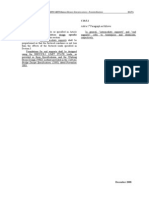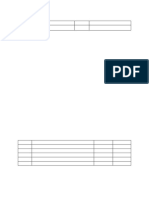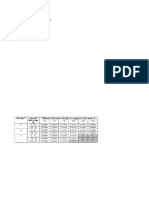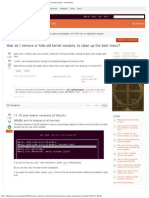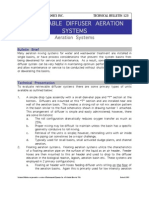BDM Section 10 - 20190101
BDM Section 10 - 20190101
Uploaded by
drmjodhpurCopyright:
Available Formats
BDM Section 10 - 20190101
BDM Section 10 - 20190101
Uploaded by
drmjodhpurOriginal Description:
Original Title
Copyright
Available Formats
Share this document
Did you find this document useful?
Is this content inappropriate?
Copyright:
Available Formats
BDM Section 10 - 20190101
BDM Section 10 - 20190101
Uploaded by
drmjodhpurCopyright:
Available Formats
SECTION 10: FOUNDATIONS 10-1
SECTION 10
FOUNDATIONS
10.1 G ENERAL SCOPE
Design of structure foundations shall be in accordance with AASHTO, project
contract documents, and CDOT Geotechnical Design Manual, unless otherwise
specified in this Section of the BDM.
10.2 GEOTECHNICAL INVESTIGATIONS
Geotechnical investigations shall be conducted in accordance with AASHTO
and the guidance provided in the CDOT Geotechnical Design Manual.
10.2.1 Ring-Lined Split Barrel Sampler
The 2.5-in. outside diameter, ring-lined split barrel sampler, often referred to as
the Modified California (MC) sampler, is routinely used in Colorado to obtain
disturbed samples of cohesive soil/rock for swell testing.
If penetration resistance values (blow counts) obtained using an MC sampler
are used in conjunction with correlations based on standard penetration test
(SPT) resistance values (N-values), the penetration resistance values should
be corrected to account for the size of the MC sampler (see Fang, 1991), as
appropriate based on the judgment of the Geotechnical Engineer.
In general, it is preferable to use SPT resistance values in SPT-based
correlations rather than to correct MC penetration resistance values.
10.2.2 Energy Measurements for Sampling Hammers
The energy delivered to drill rods when conducting SPT and MC sampling can
vary significantly depending on factors, including the type of sampling hammer,
the general condition of the hammer, and the operator. Therefore, CDOT
requires the use of sampling hammers that have been tested to determine the
actual energy transfer to the drill rods.
All sampling hammers used to complete field explorations for CDOT projects
shall be tested to determine the energy transfer ratio (the measured energy
transferred to the drill rods divided by the theoretical potential energy of the
sampling hammer) in accordance with ASTM D4633. The testing shall be
completed no more than two years before the date of sampling.
The project geotechnical report or the individual boring logs shall indicate
the energy transfer ratio. The energy transfer ratio shall also be reported on
the geology sheet. In addition, the geology sheet shall indicate whether the
reported penetration resistance values are raw values or values that have been
corrected for hammer efficiency.
CDOT Bridge Design Manual January 2018
SECTION 10: FOUNDATIONS 10-2
As appropriate for use in geotechnical evaluations, the Geotechnical Engineer
should correct penetration resistance values to an equivalent hammer efficiency
of 60 percent (N60 values).
10.3 LIMIT STATES AND RESISTANCE FACTORS
10.3.1 Service Limit State
Foundation design at the service limit state shall be in accordance with AASHTO.
10.3.2 Strength Limit State
Resistance factors at the strength limit state for foundation design shall be in
accordance with AASHTO, unless otherwise indicated in this Section of the
BDM.
10.3.3 Extreme Event Limit State
As specified by AASHTO, resistance factors for the extreme event limit state, AASHTO
including earthquake, ice, vehicle, or vessel impact loads, shall be taken as 10.5.5.3.3
1.00. For uplift resistance of piles and shafts at the extreme event limit state,
the resistance factor shall be taken as 0.80 or less.
10.4 SPREAD FOOTINGS
10.4.1 General
The Designer shall evaluate the suitability and applicability of spread footing
foundations on a case-by-case basis.
10.4.2 Footing Embedment
The base of spread footings on soil shall be embedded below the local or regional AASHTO
frost depth, with a minimum embedment of 3 ft. The minimum embedment of 10.6.1.2
spread footings on bedrock may be reduced to less than 3 ft. based on the
recommendation of the Geotechnical Engineer.
For establishing spread footing embedment into stream banks based on scour
considerations, see Section 2.11.2 of this BDM.
The requirements of this section do not apply to MSE wall footers. Refer to
current Staff Bridge Worksheets for MSE Walls for MSE wall requirements
10.4.3 Tolerable Movements
Tolerable foundation movements shall be in accordance with AASHTO. As AASHTO
noted by AASHTO, angular distortions between adjacent foundations should 10.5.2.2,
not exceed 0.008 radians in simple spans and 0.004 radians in continuous C10.5.2.2
spans.
Consistent with AASHTO, transient loads may be omitted from time-dependent
settlement analyses at the Service I Load Combination.
CDOT Bridge Design Manual January 2019
SECTION 10: FOUNDATIONS 10-3
10.5 DRIVEN PILES
10.5.1 General
10.5.1.1 Pile Types
Driven H-piles are frequently used to support structures in Colorado. In most
applications, H-piles are driven to practical refusal on bedrock. H-pile sections
are supplied standard as Grade 50 steel (fy = 50 ksi).
For bridges, the most readily available H-pile sections include:
• HP 14x89
• HP 12x74
• HP 12x53
Other H-pile sizes may be used when availability is verified with local suppliers
and when any delays due to custom pile orders do not negatively affect the
project schedule.
Although less frequently used in Colorado, other pile types may be feasible and
preferable to H-piles depending on project requirements. For instance, closed-
end pipe piles may be advantageous at sites with relatively deep bedrock,
where a closed-end pipe pile may develop greater axial resistance at shallower
depths compared to a comparable H-pile section. Sheet piles may be used
for foundation support, especially for projects where such use may benefit the
construction schedule or cost.
When using a less common pile type, the Designer shall confirm that the
selected pile section is available from local suppliers.
10.5.1.2 Battered Piles
Battered piles may be used to increase lateral resistance of driven piles. The AASHTO
Designer should consider that battered piles will provide a stiffer lateral response 10.7.1.4
than that of vertical piles.
Where used, the preferred pile batter is 1 horizontal to 6 vertical (1H:6V). The
maximum batter of driven piles shall not exceed 1H:4V due to constructability
considerations.
Piles less than 15 ft. in length and driven to refusal on bedrock shall not be
battered.
10.5.1.3 Embedment
The Designer should consider the potential for piles to encounter refusal on
bedrock or obstructions, such as boulders, before reaching the depth required
for stability under axial and lateral loading. The Designer may specify a minimum
tip elevation on the plans to address this issue. Pre-boring may be used in
cases where refusal is anticipated to occur above the required minimum tip
elevation, although the Designer should consider using other foundation types
that may be preferable in terms of design or constructability.
CDOT Bridge Design Manual January 2018
SECTION 10: FOUNDATIONS 10-4
10.5.1.4 Corrosion of Piles in Soil/Rock
In aggressive soil/rock, the Designer shall incorporate appropriate corrosion AASHTO 10.7.5
mitigation measures. Acceptable corrosion mitigation measures for driven piles
include the use of sacrificial steel, concrete encasement, and factory-applied
coatings in combination with a reduced thickness of sacrificial steel. Field-
applied coatings shall not be used, except as repairs to factory-applied coatings.
Weathering steel is not considered a mitigation measure for corrosion.
In general, corrosion of steel piles is greatest in soils that have been disturbed,
that is, where earthwork activities have occurred. Compared to undisturbed
soils, disturbed soils have increased oxygen content, which supports corrosion.
In undisturbed soils, corrosion may occur in the zone of unsaturated soil above
the groundwater table. Corrosion may be exacerbated in the zone of fluctuation
of the groundwater table. Significant corrosion does not generally occur in
undisturbed soil/rock below the groundwater table.
In soil/rock above the groundwater table, the Geotechnical Engineer shall
conduct corrosion testing of representative soil/rock samples. If any of the
following conditions exist, the soil/rock shall be classified as aggressive:
• Resistivity is less than 2,000 ohm-cm.
• pH is less than 5.5.
• pH is between 5.5 and 8.5 in soils with high organic content.
• Sulfate concentration is greater than 1,000 parts per million (ppm).
• Chloride concentration is greater than 500 ppm.
Where corrosion testing indicates aggressive soil/rock, the Geotechnical
Engineer shall indicate the elevation range(s) where the aggressive soil/rock is
anticipated based on test results.
Where aggressive soil/rock is present, the thickness of sacrificial steel shall
be calculated based on a minimum corrosion rate of 0.001 in. per year.
Published corrosion rates vary widely. The specified minimum corrosion rate
is based on criteria established by the California Department of Transportation
(2013), the US Army Corps of Engineers (2012), and the Florida Department of
Transportation (2016).
The Designer shall assume that corrosion occurs over all steel surfaces in
contact with the aggressive soil/rock. Corrosion rates greater than the minimum
value specified herein may be appropriate, particularly where piles are installed
in landfill materials, cinder fills, organic soils, or mine waste/drainage. Corrosion
mitigation is not required in soil/rock below the groundwater table.
If factory-applied coal-tar epoxy coating is used for corrosion mitigation,
the coating shall be assumed to be effective for 30 years. In calculating the
sacrificial steel thickness, the Designer shall assume corrosion begins after the
first 30 years and continues through the remaining design life, as appropriate.
CDOT Bridge Design Manual January 2018
SECTION 10: FOUNDATIONS 10-5
If protective coatings are used, the Geotechnical Engineer shall provide
appropriate axial design parameters accounting for a potential reduction in side
resistance.
Sacrificial steel is not necessary where concrete encasement is used for AASHTO C10.7.5
corrosion mitigation. Piles protected by concrete encasement should be coated
with a dielectric coating near the base of the concrete jacket.
10.5.1.5 Corrosion of Piles Exposed to Atmospheric Conditions
The following provisions apply only to situations where piles are extended
above the ground, such as sheet pile abutments or H-pile/pipe pile piers.
For non-weathering steel piles, aggressive conditions shall be assumed for the
first 5 ft. of pile below grade and for the entire portion of the pile exposed to
atmospheric conditions.
Corrosion mitigation is not required for weathering steel piles exposed to
atmospheric conditions and not located within the splash zone or underneath a
bridge expansion joint.
Corrosion mitigation for the remaining portion of piles embedded in soil/rock
shall be as required in Section 10.5.1.4, for both non-weathering and weathering
steel piles.
10.5.1.6 Pile Cap Embedment
For establishing pile cap footing embedment into stream banks based on scour AASHTO
considerations, see Section 2.11.2 of this BDM. 2.6.4.4.2
10.5.2 Geotechnical Design and Analysis
10.5.2.1 Point Bearing Piles on Rock
Piles that will penetrate the bedrock 3 ft. or more shall be designed in accordance AASHTO
with the requirements specified by AASHTO for “Piles Driven to Soft Rock.” Piles 10.7.3.2.2 &
that will penetrate the bedrock less than 3 ft. shall be designed in accordance 10.7.3.2.3
with the requirements specified by AASHTO for “Piles Driven to Hard Rock.”
In general, it is anticipated that piles driven into the relatively weak sedimentary
bedrock typically encountered along the Front Range would classify as “Soft
Rock,” while piles driven to higher strength bedrock where significant bedrock
penetration is not typically achieved would classify as “Hard Rock.”
Pile protection (tips, points, or shoes) shall be included for all piles driven to
bedrock.
10.5.2.2 Small Groups of Piles
At the strength limit state, the resistance factor for geotechnical axial resistance AASHTO
shall be reduced by 20 percent for groups of piles containing three or fewer C10.5.5.2.3
piles, unless otherwise approved by Staff Bridge.
CDOT Bridge Design Manual January 2019
SECTION 10: FOUNDATIONS 10-6
10.5.2.3 Drivability Analysis
CDOT Standard Specification 502 provides requirements for pile drivability AASHTO 10.7.8
analyses (wave equation analysis of pile driving [WEAP]). The Contractor
typically completes WEAP.
The Geotechnical Engineer should consider completing WEAP during the
design phase when:
• A pile type, section, or driving procedure not routinely used in local practice
(see Section 10.5.1.1) is proposed.
• A pile with an axial resistance greater than what is typically used in local
practice or which may require the use of a pile driving hammer larger than
typically used in Colorado (nominal resistance greater than approximately
500 kip) is proposed.
• A pile will be driven into a relatively deep bearing layer such that the driving
resistance is likely to exceed the required geotechnical axial resistance
(over-driving).
10.5.3 Top of Pile Fixity
The following simplified method may be used to calculate the minimum pile
embedment required to classify the connection at the top of the pile as fixed.
Figure 10-1: Pile Fixity
Where:
L = Required pile embedment into cap (in.)
φ= Strength reduction factor for concrete bearing = 0.7 (AASHTO 5.5.4.2)
f’c = 28-day compressive strength of concrete (ksi)
Mup = Plastic moment capacity of pile about strong axis (kip-in.)
bf = Pile flange width (in.)
CDOT Bridge Design Manual January 2019
SECTION 10: FOUNDATIONS 10-7
Table 10-1 presents the calculated embedments for the most common HP
shapes, based on a φ of 0.7 and f’c of 4.5 ksi.
Table 10-1: Calculated Embedments
Minimum
HP Pile Section
Embedment (in.)
12x53 20
12x74 24
14x89 26
For specific criteria regarding pile embedment at integral abutments, see BDM
Section 11.
10.5.4 Field Splice
The Designer shall note on the plans the elevation above which complete joint
penetration (CJP) welds are required for the flanges of all H-pile field splices.
The Designer shall also note on the plans that below this elevation, partial joint
penetration (PJP) flange welds or other commercially available splices using
mechanical connections may be permitted upon review by the Engineer. The
elevation shall be taken as the lowest primary moment inflection point in the
pile obtained from all load combinations producing bending moment in the
pile, including scour and extreme event load cases (see Figure 10-2). At the
Designer’s discretion, piles that are not subjected to significant bending moment
may be exempt from this provision.
Figure 10-2: Moment Inflection Point and H-Pile Field Splices
CDOT Bridge Design Manual January 2018
SECTION 10: FOUNDATIONS 10-8
10.5.5 Dynamic Testing
As required by AASHTO and CDOT Standard Specification 502, dynamic testing AASHTO
shall be completed during pile installation to monitor potential pile damage, to 10.7.3.8.3
determine axial resistance, and to establish driving criteria.
In accordance with AASHTO, higher resistance factors for geotechnical axial AASHTO Table
resistance may be used if dynamic testing is completed during pile installation. 10.5.5.2.3-1
The Designer should note that for bridges with more than 100 piles, the test
frequency required by AASHTO to use a resistance factor of 0.65 is more
stringent than the test frequency required by CDOT Standard Specification 502.
Therefore, if a resistance factor of 0.65 is used for a bridge with more than
100 piles, a Project Special Provision is required to modify the dynamic testing
frequency indicated in the Standard Specification to maintain compliance with
AASHTO.
10.5.6 Plan Requirements
As applicable, the following information shall be included in a table in the
plans:
• Pile size
• Maximum factored axial load per pile
• Maximum service load per pile
• Cutoff elevation
• Estimated bedrock elevation
• Estimated tip elevation
• Scour elevation
• Minimum required tip elevation (see Section 10.5.1.3 for applicability)
• CJP minimum splice elevation (see Section 10.5.4 for applicability)
• A location to record the as-built tip elevation of each pile
The plan notes shall indicate:
• The assumed strength limit resistance factor for geotechnical axial
resistance
• The steel grade
• If the pile is designed for side resistance, end bearing, or both
• The field splice requirements as a function of CJP minimum splice elevation
(see Section 10.5.4 for applicability)
CDOT Bridge Design Manual January 2018
SECTION 10: FOUNDATIONS 10-9
10.5.7 Load Testing
Load testing (axial or lateral) may be conducted to justify the use of increased
resistance factors and to reduce uncertainty in the performance of driven piles.
During the structure selection process, the Designer shall review and evaluate
the need, benefits, and feasibility of conducting load testing.
When load testing is completed, the entity completing the load test shall prepare
a report sealed by a professional engineer licensed in the State of Colorado
summarizing test results.
10.6 DRILLED SHAFTS
The term “drilled shaft” as used herein is interchangeable with drilled pier, drilled
caisson, and other similar terms.
10.6.1 General
10.6.1.1 Geometry and Dimensions
Drilled shafts used to support bridges and retaining walls shall have a minimum
diameter of 24 in. Drilled shafts used to support sound walls shall have a
minimum diameter of 18 in. Length to diameter ratios, L/D, are typically less
than 25.
Where a drilled shaft supports a single column, the top of shaft shall be
embedded a minimum of 2 ft. below ground surface, unless the Geotechnical
Engineer recommends deeper embedment.
In contrast to AASHTO, CDOT allows the use of drilled shafts that are smaller in AASHTO
diameter than the columns they support. This allows constructability advantages, 10.8.1.3
such as eliminating the need for separate column dowels embedded into the
caisson.
10.6.1.2 Tip Elevation
The Designer shall add a note on the plans requiring drilled shafts to be
advanced to the estimated tip elevation or to the minimum penetration into
bedrock, whichever produces the lower tip elevation. No allowance will be
made to terminate the drilled shafts above the estimated tip elevation on
account of encountering bedrock above the anticipated elevation or any other
circumstances.
10.6.2 Geotechnical Design and Analysis
10.6.2.1 Axial Resistance in Weak Rock
Rock-socketed drilled shafts are frequently used in Colorado. SPT-based
methods are often used to estimate the axial resistance of sedimentary bedrock
encountered along the Front Range. For sites with bedrock N-values typically
between 20 and 100 blows per foot, the “soil-like claystone” design procedure
described by Abu-Hejleh et al. (2003) may be used to determine nominal unit
side resistance and end bearing values.
CDOT Bridge Design Manual January 2018
SECTION 10: FOUNDATIONS 10-10
The resistance factor of 0.75 recommended by Abu-Hejleh et al. (2003) for the AASHTO Table
“soil-like claystone” method shall not be used because this value exceeds typical 10.5.5.2.4-1
resistance factors specified by AASHTO, including the maximum resistance
factor of 0.70, which assumes load testing is completed.
A resistance factor of 0.60 shall be used with the “soil-like claystone” method
(Abu-Hejleh et al., 2003). The resistance factor was calculated by fitting to
allowable stress design (ASD) assuming the following:
• Ratio between permanent and live loads of 3:1
• Permanent Load Factor of 1.25
• Live Load Factor of 1.75
• Factor of Safety of 2.25
For sites with bedrock N-values typically greater than 100 and where rock coring AASHTO
produces suitable core recovery (i.e., samples can be recovered for strength 10.8.3.5
testing and the rock mass can be characterized to an appropriate degree), it
is preferable to evaluate axial resistance using design methods based on the
unconfined compressive strength, as described in AASHTO and FHWA Report
No. FHWA-NHI-10-016 (Brown et al., 2010).
10.6.2.2 Roughening and Shear Rings
Roughening may be completed to remove smeared or disturbed materials from
the sides of drilled shaft excavations. The Geotechnical Engineer shall indicate
when roughening is required.
Because shear rings are difficult to inspect, they shall not be used unless
approved by Staff Bridge. As an alternative to using shear rings to increase
axial resistance, the drilled shaft could be lengthened or increased in diameter.
10.6.3 Non-destructive Integrity Testing
10.6.3.1 Test Methods
Cross-hole sonic logging (CSL) is an acceptable non-destructive method to
evaluate the integrity of completed drilled shafts. Thermal Integrity Profiling
(TIP) may be used with approval from Staff Bridge. If TIP is specified, the
designer shall prepare an appropriate Project Special Provision.
Methods based on the analysis of stress waves, such as sonic echo and impulse
response, shall not be used as the primary test method unless access tubes
are unavailable.
All testing shall be completed in accordance with the applicable ASTM standards.
CDOT Bridge Design Manual January 2018
SECTION 10: FOUNDATIONS 10-11
10.6.3.2 Test Frequency
The requirements presented in this section are only applicable to drilled shafts
used as bridge foundations. The frequency of integrity testing for drilled shafts
used in other applications (retaining structures, landslide stabilization, etc.)
shall be at the discretion of the Designer, as approved by Staff Bridge. As
necessary for non-bridge applications, the Designer should prepare a Project
Special Provision to specify the desired test frequency.
CSL access tubes shall be installed in all non-redundant drilled shafts. With
respect to CSL testing requirements, a non-redundant drilled shaft is defined as
any drilled shaft at an abutment or a pier supported by two or fewer drilled shafts.
CSL access tubes shall also be installed in all drilled shafts to be constructed
in a water crossing and in all drilled shafts that will be constructed in soil/rock
requiring the use of temporary excavation support (i.e. casing or drilling fluid).
At the discretion of the Designer, other drilled shafts on the project may be
selected to require CSL testing, such as largely spaced shafts.
CSL testing shall be completed on all non-redundant drilled shafts. CSL testing
shall be completed on a minimum of 50 percent of drilled shafts equipped with
CSL access tubes, at the discretion of the Engineer. If CSL testing indicates
anomalies, the remaining drilled shafts at the pier/abutment shall also be tested.
Installation of CSL access tubes and integrity testing are not required for drilled
shafts with permanent casing socketed into bedrock, regardless of redundancy
or shaft location.
Other agencies, such as railroads, may have more stringent testing requirements.
The designer shall determine if any non-CDOT entities have applicable testing
requirements.
The Designer shall indicate in the plans the minimum number of drilled shafts
to be tested.
10.6.3.3 Addressing Anomalies
Anomalies indicated by CSL testing shall be addressed in accordance with
Standard Specification 503.
Guidance on repairing drilled shaft anomalies is described in FHWA Report No.
FHWA-NHI-10-016 (Brown et al., 2010). Additional information is provided in
the ADSC – IAFD Standard Drilled Shaft Anomaly Mitigation Plan (Association
of Drilled Shaft Contractors – International Association of Foundation Drilling,
2014).
If test methods other than CSL are proposed, the Designer shall specify criteria
for the evaluation and acceptance of test results in a Project Special Provision.
CDOT Bridge Design Manual January 2018
SECTION 10: FOUNDATIONS 10-12
10.6.4 Load Testing
Load testing (axial or lateral) may be conducted to justify the use of increased
resistance factors and to reduce uncertainty in the performance of drilled shafts.
During the structure selection process, the Designer shall review and evaluate
the need, benefits, and feasibility of conducting load testing.
When load testing is completed, the entity completing the load test shall prepare
a report sealed by a professional engineer licensed in the State of Colorado
summarizing test results. The report shall include all necessary information and
data to enter the test into the DSHAFT load test database (see Garder et al.,
2012).
10.6.5 Plan Requirements
As applicable, the following information shall be included in a table in the plans:
• Drilled shaft diameter
• Maximum factored axial load per drilled shaft
• Maximum service load per drilled shaft
• Top of drilled shaft elevation
• Estimated bedrock elevation
• Minimum bedrock penetration
• Estimated tip elevation
• Scour elevation
• A location to record the as-built bedrock and tip elevation of each drilled
shaft
The plan notes shall indicate:
• The assumed strength limit resistance factor for geotechnical axial
resistance
• If the drilled shaft is designed for side resistance, end bearing, or both
• The number of drilled shafts, by substructure element, to be tested using
non-destructive integrity testing per Section 10.6.3.2
• The minimum total number of drilled shafts to be tested using non-
destructive integrity testing per Section 10.6.3.2
• Embedment criteria regarding tip elevation per Section 10.6.1.2
10.7 R EFERENCES
Abu-Hejleh, N., O’Neill, M.W., Hanneman, D., Atwooll, W.J., 2003, Improvement
of the Geotechnical Axial Design Methodology for Colorado’s Drilled Shafts
Socketed in Weak Rocks, Report No. CDOT-DTD-R-2003-6.
AASHTO, 2014, LRFD Bridge Design Specifications, 7th edition, American
Association of State Highway and Transportation Officials.
CDOT Bridge Design Manual January 2018
SECTION 10: FOUNDATIONS 10-13
Association of Drilled Shaft Contractors – The International Association of
Foundation Drilling, 2014, Standard Drilled Shaft Anomaly Mitigation Plan,
ADSC Drilled Shaft Committee, November.
Brown, D.A., Turner, J.P., Castelli, R.J., 2010 Drilled Shafts: Construction
Procedures and LRFD Design Methods, NHI Course No. 132014, Geotechnical
Engineering Circular No. 10, Report No. FHWA NHI-10-016.
California Department of Transportation, 2013, Memo to Designers 3-1, Deep
Foundations, August.
Colorado Department of Transportation, 2015, Geotechnical Design Manual,
Draft.
Florida Department of Transportation, 2016, Structures Design Guidelines,
Vol. I, January.
Garder, J.A., Ng, K.W., Sritharan, Sri, and Roling, M.J., 2012, Development of a
Database for Drilled SHAft Foundation Testing (DSHAFT), Report No. 10-366,
Bridge Engineering Center, Institute for Transportation, Iowa State University.
Fang, 1991, Foundation Engineering Handbook, 2nd edition, Van Nostrand
Reinhold, New York.
US Army Corps of Engineers, 2012, Hurricane and Storm Damage Risk
Reduction System Design Guidelines, Chapter 5, March.
CDOT Bridge Design Manual January 2018
You might also like
- GP 04.01.01Document13 pagesGP 04.01.01Jose VasquezNo ratings yet
- BCA 101 SolvedDocument15 pagesBCA 101 SolvedGhanshyam Sharma33% (3)
- Flame UniversityDocument1 pageFlame UniversityNiveditha BalachandranNo ratings yet
- Design Guide of Slab On GradeDocument20 pagesDesign Guide of Slab On GradePriyanka100% (2)
- Particular Specification For Rock-Socketed Steel H-PiwefwlesDocument15 pagesParticular Specification For Rock-Socketed Steel H-PiwefwlesLee Tin YanNo ratings yet
- Bridge Technical NoteDocument5 pagesBridge Technical Noteপ্রিয়দীপ প্রিয়মNo ratings yet
- 125 PWC Canadian Master SpecificationsDocument0 pages125 PWC Canadian Master Specificationsaggibudiman100% (1)
- Seismic Design of Water TanksDocument17 pagesSeismic Design of Water TanksJeevan ReddyNo ratings yet
- Astm C1491Document3 pagesAstm C1491BeymerBustamanteMejíaNo ratings yet
- Reinforced Concrete Buildings: Behavior and DesignFrom EverandReinforced Concrete Buildings: Behavior and DesignRating: 5 out of 5 stars5/5 (1)
- Reinforced Concrete Grade Beams, Piles & Caissons: A Practical Guide for Hillside ConstructionFrom EverandReinforced Concrete Grade Beams, Piles & Caissons: A Practical Guide for Hillside ConstructionNo ratings yet
- Coiled Tubing Operations at a Glance: What Do You Know About Coiled Tubing Operations!From EverandCoiled Tubing Operations at a Glance: What Do You Know About Coiled Tubing Operations!Rating: 5 out of 5 stars5/5 (2)
- Standard Specifications Geotechnical Design Manual: Walls and Buried StructuresDocument10 pagesStandard Specifications Geotechnical Design Manual: Walls and Buried StructuresAnonymous ELujOV3No ratings yet
- GM VerticalGroundAnchors A11yDocument8 pagesGM VerticalGroundAnchors A11yTin Win HtutNo ratings yet
- Foundation Design IsOCD 19902Document38 pagesFoundation Design IsOCD 19902Abdulkadir DinçerNo ratings yet
- BS8500Document29 pagesBS8500Heba MahmoudNo ratings yet
- Installation of Precast Reinforced Concrete Monolithic Box Sections For Culverts, Storm Drains, and SewersDocument4 pagesInstallation of Precast Reinforced Concrete Monolithic Box Sections For Culverts, Storm Drains, and SewersEligio Antonio CerdaNo ratings yet
- Culvert Design Checklist 2019Document5 pagesCulvert Design Checklist 2019zeroicesnowNo ratings yet
- 3 1 PDFDocument13 pages3 1 PDFlundumarulituasinuraNo ratings yet
- Bridge Technical Note 2023 - 023 AS5100 Part 3 v20 July 2023Document11 pagesBridge Technical Note 2023 - 023 AS5100 Part 3 v20 July 2023roshansm1978No ratings yet
- Metodology GeotechnicalDocument9 pagesMetodology GeotechnicalMuhamad MukhrizNo ratings yet
- Chapter 15 Shallow Foundations - 02242010Document8 pagesChapter 15 Shallow Foundations - 02242010Tolaz KoyiNo ratings yet
- CDOT Bridge Design Manual - Section - 11 - 2022Document50 pagesCDOT Bridge Design Manual - Section - 11 - 2022Liu ZhenguoNo ratings yet
- Section 11 Abutment, Piers, and Retaining Walls Section 11 Abutment, Piers, and Retaining WallsDocument48 pagesSection 11 Abutment, Piers, and Retaining Walls Section 11 Abutment, Piers, and Retaining WallsDeepak Kr GuptaNo ratings yet
- Seismic Foundation Design Practice Nov2005Document26 pagesSeismic Foundation Design Practice Nov2005taosyeNo ratings yet
- Choice of Foundation For BrigdesDocument15 pagesChoice of Foundation For BrigdesSamuel AntobamNo ratings yet
- A A A A A A 10Document62 pagesA A A A A A 10firasslmnNo ratings yet
- Jong Jordan Menard 14YPGC FinalDocument6 pagesJong Jordan Menard 14YPGC FinalHasantha KodithuwakkuNo ratings yet
- WRD14 (545) P PDFDocument34 pagesWRD14 (545) P PDFer.dksahoiNo ratings yet
- 12 2019 PDFDocument22 pages12 2019 PDFHpeso EmohseNo ratings yet
- BDM Section 11 - 20190101Document48 pagesBDM Section 11 - 20190101drmjodhpur100% (1)
- Pile DrivingDocument15 pagesPile DrivingiGp2013No ratings yet
- BDM Section 11 - 20180101Document48 pagesBDM Section 11 - 20180101John STCNo ratings yet
- BDM Section 11 - 20180101 PDFDocument48 pagesBDM Section 11 - 20180101 PDFHabeeb ShaikNo ratings yet
- Ur s10 Rev.7 Feb 2023ulDocument43 pagesUr s10 Rev.7 Feb 2023ulApoorv SinghNo ratings yet
- GM CIDHPiles A11yDocument30 pagesGM CIDHPiles A11yaizaz ahmadNo ratings yet
- Soldier Pile and Lagging Design RequirementsDocument3 pagesSoldier Pile and Lagging Design Requirementsshaik mohammed ArshadNo ratings yet
- Cms 830 03 GL 70021 Jacket Foundation DesignDocument23 pagesCms 830 03 GL 70021 Jacket Foundation DesignRajesh DodejaNo ratings yet
- Ref. Title No.: 10.1 Piling: GeneralDocument9 pagesRef. Title No.: 10.1 Piling: GeneralJithesh.k.sNo ratings yet
- IRS Seismic Code 2017 PDFDocument39 pagesIRS Seismic Code 2017 PDFvigneshrajamanickamNo ratings yet
- CPAA Guidance Note NZ Loads On Circular Precast Concrete Manholes and MoreDocument8 pagesCPAA Guidance Note NZ Loads On Circular Precast Concrete Manholes and Morejunhe898No ratings yet
- 3550-8310-SP-0006 Rev D2.pdf MARKED-c.vanDocument8 pages3550-8310-SP-0006 Rev D2.pdf MARKED-c.vanPhuong ThaoNo ratings yet
- BRIDGE DESIGN AID 2004 Sep PDFDocument20 pagesBRIDGE DESIGN AID 2004 Sep PDFAnonymous hbAzrkJ100% (1)
- Pages From 177344845 Aashto LRFD 4th 2007Document2 pagesPages From 177344845 Aashto LRFD 4th 2007vrajan1988No ratings yet
- Handbook On Railway Construction-401-500Document100 pagesHandbook On Railway Construction-401-500yamegNo ratings yet
- Soldier Piles WashingtonDocument4 pagesSoldier Piles WashingtonSteven SebastianNo ratings yet
- Base Design and Founadtion Installation Design Feasibility Study ETSU W/62/00568/REP DTI /pub URN 01/1518Document13 pagesBase Design and Founadtion Installation Design Feasibility Study ETSU W/62/00568/REP DTI /pub URN 01/1518premasiri karunarathneNo ratings yet
- Principal Types of FoundationsDocument18 pagesPrincipal Types of FoundationsAndré OliveiraNo ratings yet
- Rigid Pavement ManualDocument30 pagesRigid Pavement ManualSarfaraj KhanNo ratings yet
- 1 PDFDocument22 pages1 PDFNeeraj Sharma0% (1)
- C1479Document8 pagesC1479Jesús Ernesto Flores RamírezNo ratings yet
- For Official Use Only DOC: WRD 14 (546) P: Preliminary Draft Indian StandardDocument8 pagesFor Official Use Only DOC: WRD 14 (546) P: Preliminary Draft Indian StandardSouvik DasNo ratings yet
- C1479 Hlja5316Document9 pagesC1479 Hlja5316Brisa YulietNo ratings yet
- Fundarmental Design ProcessDocument34 pagesFundarmental Design ProcesstitilopeoyaremiNo ratings yet
- Checklist For DG Set Foundation Design & DrawingDocument3 pagesChecklist For DG Set Foundation Design & DrawingRupesh KhandekarNo ratings yet
- Is 15284 Part I - 2003Document22 pagesIs 15284 Part I - 2003231340No ratings yet
- 2014 Reff2020Document15 pages2014 Reff2020Naresh ANo ratings yet
- Durability Design of Concrete Structures: Phenomena, Modeling, and PracticeFrom EverandDurability Design of Concrete Structures: Phenomena, Modeling, and PracticeNo ratings yet
- Sewage Disposal Works: Their Design and ConstructionFrom EverandSewage Disposal Works: Their Design and ConstructionNo ratings yet
- Mob Net 2011 Exam SolutionDocument13 pagesMob Net 2011 Exam Solutionمحيي الدين الكميشىNo ratings yet
- Tourist Satisfaction at Baliati Zamindar BariDocument10 pagesTourist Satisfaction at Baliati Zamindar Barimda958605No ratings yet
- Business Process ManagementDocument17 pagesBusiness Process ManagementOmar Ahmed ElkhalilNo ratings yet
- Hot & Dry Climate Case StudyDocument25 pagesHot & Dry Climate Case StudyAkanksha BhakareNo ratings yet
- Custodio - Research & Design ConceptDocument4 pagesCustodio - Research & Design ConceptNicole CustodioNo ratings yet
- Vehicle-to-Vehicle Safety Messaging in DSRCDocument10 pagesVehicle-to-Vehicle Safety Messaging in DSRCAnupam SamantaNo ratings yet
- How Do I Remove or Hide Old Kernel Versions, To Clean Up The Boot MeDocument19 pagesHow Do I Remove or Hide Old Kernel Versions, To Clean Up The Boot Mekoulis123No ratings yet
- Honors Syllabus Architecture and Town Planning - 02.09.2021Document8 pagesHonors Syllabus Architecture and Town Planning - 02.09.2021dnyaneshwar.kakade22No ratings yet
- Evaporadortipocassetter22 2Document6 pagesEvaporadortipocassetter22 2dom007thyNo ratings yet
- Ourlog 2817Document2 pagesOurlog 2817TobiiツNo ratings yet
- Nibe Install Manual f2300Document52 pagesNibe Install Manual f2300Zo NetNo ratings yet
- Mix Design For Segments of 80 MPaDocument4 pagesMix Design For Segments of 80 MPaForood TorabianNo ratings yet
- Basilica Cistern HoDocument4 pagesBasilica Cistern HoRichie Juls Bacalso100% (1)
- Documentation Final Portfolio-MergedDocument14 pagesDocumentation Final Portfolio-MergedPiyush GoelNo ratings yet
- Big Data Assignment RevisedDocument4 pagesBig Data Assignment RevisedHarshit SukhijaNo ratings yet
- Ist FloorDocument1 pageIst FloorAnkur wilmangroupindiaNo ratings yet
- BOQ NGP EarthworkDocument2 pagesBOQ NGP EarthworkrrpNo ratings yet
- Pipe and Tube Bending PrinciplesDocument5 pagesPipe and Tube Bending PrinciplesPravin SatheNo ratings yet
- Cissp Osi LayerDocument10 pagesCissp Osi LayerJey BoseNo ratings yet
- Art Nouveau..FinalDocument19 pagesArt Nouveau..FinalMahak GuptaNo ratings yet
- Durga Petals BrochureDocument14 pagesDurga Petals BrochureckNo ratings yet
- 04.8279-Key Board DisplayDocument31 pages04.8279-Key Board Displaysasi_kar_1No ratings yet
- Building WorksDocument44 pagesBuilding Worksafiq91No ratings yet
- RetrivableDocument2 pagesRetrivableAmit KumarNo ratings yet
- Minutes of Meeting 3rd Sem Held On 14th JuneDocument2 pagesMinutes of Meeting 3rd Sem Held On 14th JuneArchana GopalsamyNo ratings yet
- 1884 World S Fair and and Cotton Exposition New Orleans Guidebook 2 PDFDocument106 pages1884 World S Fair and and Cotton Exposition New Orleans Guidebook 2 PDFDrumm ErNo ratings yet
- Limelight - Tower Unit Detail - 11-09-2024Document1 pageLimelight - Tower Unit Detail - 11-09-20241divyeshkhokharaNo ratings yet
- Emperor of Byzantine Empire Who Codified Roman Laws and Responsible For Rebuilding of SDocument2 pagesEmperor of Byzantine Empire Who Codified Roman Laws and Responsible For Rebuilding of SJay MarkNo ratings yet



























